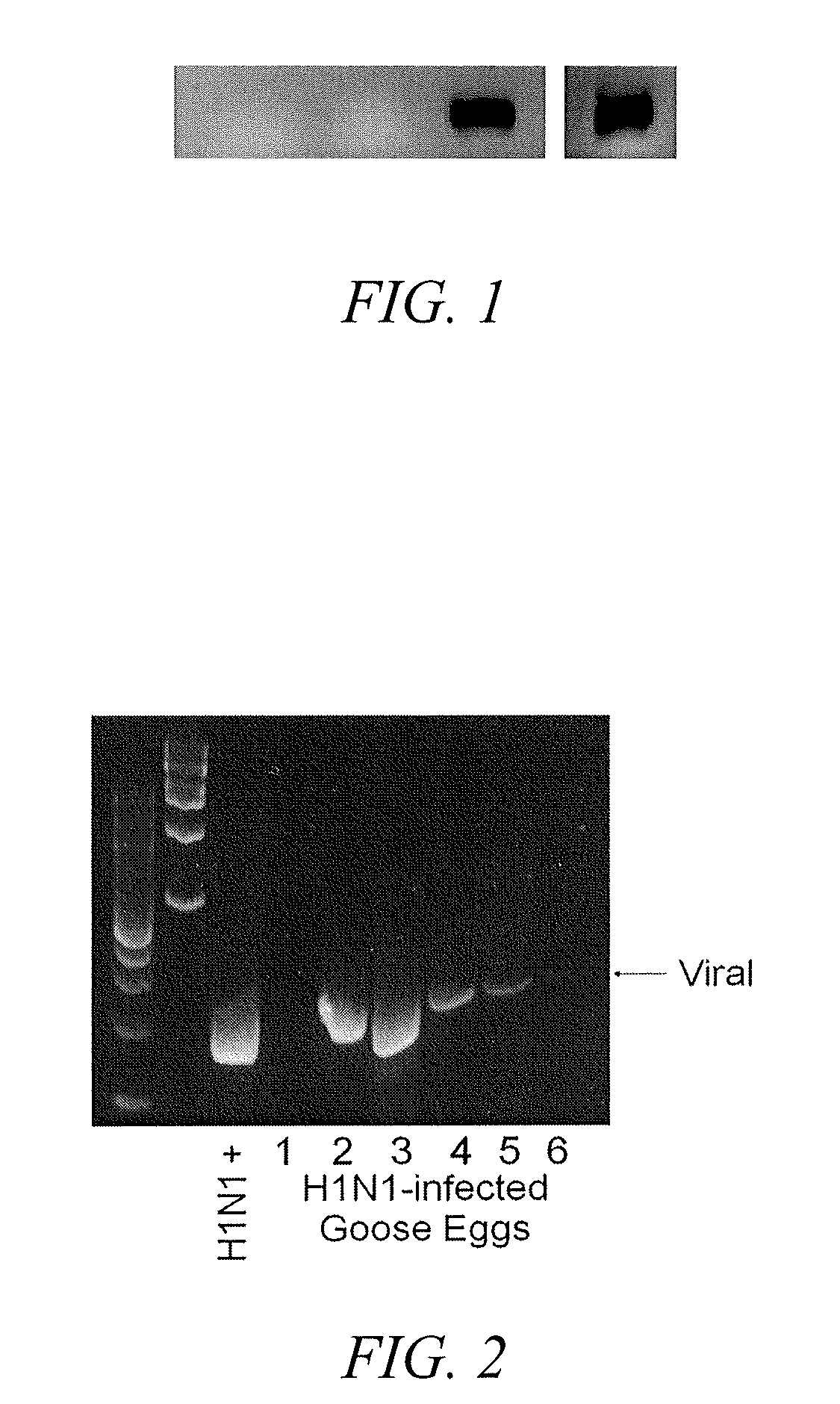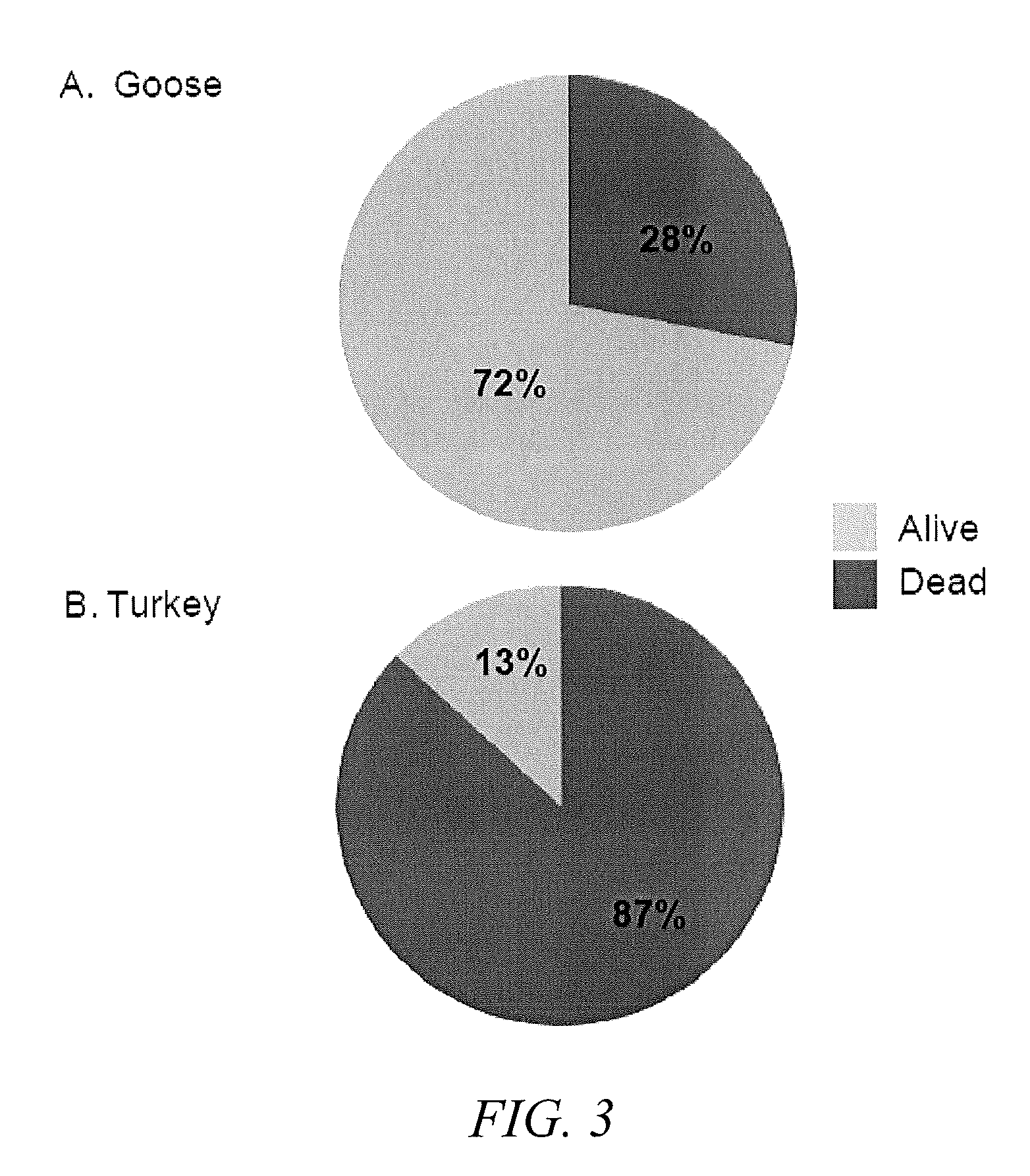Vaccine Production For Pathogenic Bird Viral Diseases
a technology for poultry and vaccines, applied in the field of vaccines for pathogenic bird viral diseases, can solve the problems of less effective vaccines for current strains, two limitations, and killing not only domesticated chickens but also chicken embryos, so as to improve the pathogenicity of chicken embryos, improve the production of vaccines, and reduce the effect of virus production
- Summary
- Abstract
- Description
- Claims
- Application Information
AI Technical Summary
Benefits of technology
Problems solved by technology
Method used
Image
Examples
example 1
Production of Avian Influenza Virus in Waterfowl Embryos
[0047]A stock sample of H3N2 was obtained from ATCC (VR-777) culture collection and used as a viral stock for injection into waterfowl eggs. Two lines, P2SM and JMOP, of goose embryos were used for virus production. Goose embryos at 11 to 17 days of incubation were candled for viability prior to viral injection. Holes were drilled at positions on egg that provided access to either the air sac or chorioallantoic membranes. Approximately 10 to 100 ul of virus stock solution was placed in the air sac or injected into the chorioallantoic membrane using a 26 gauge needle. The hole was sealed using Elmers glue and returned in the upright position into an incubator. The eggs were monitored for viability by candling.
[0048]After 3 to 6 days, approximately 0.5-1.0 ml of allantoic fluid were collected from the allantoic cavity of the goose embryos. Samples of the fluid were extracted for RNA and analyzed according to the protocol recommen...
example 2
Differential Production of Bird Influenza Virus in Bird Embryos with Differential Viral Resistance
[0051]Among the many low pathogenicity strains of influenza virus, there are few reports of unique species-specific susceptibility. However, there are several reports, including a study in northern Europe that report the susceptibility of turkeys to H1N1 (Ludwig, S., Haustein, A., Kaleta, E. F. & Scholtissek, C. (1994). Recent influenza A (H1N1) infections of pigs and turkeys in northern Europe. Virology, 202, 281-286), while there are no known reports of geese susceptible to H1N1 strains. Therefore, to determine if this susceptibility difference between geese and turkeys was also present in the eggs of these two species, goose and turkey eggs were infected with H1N1 (A / Mal / 302 / 54; ATCC VR-98) influenza virus as described in Example 1. The mass of goose compared to turkey eggs was determined to be 2:1, and therefore, standard viral dose used to infect goose eggs, 1×106 virons / egg was ad...
PUM
| Property | Measurement | Unit |
|---|---|---|
| time | aaaaa | aaaaa |
| resistance | aaaaa | aaaaa |
| time | aaaaa | aaaaa |
Abstract
Description
Claims
Application Information
 Login to View More
Login to View More - R&D
- Intellectual Property
- Life Sciences
- Materials
- Tech Scout
- Unparalleled Data Quality
- Higher Quality Content
- 60% Fewer Hallucinations
Browse by: Latest US Patents, China's latest patents, Technical Efficacy Thesaurus, Application Domain, Technology Topic, Popular Technical Reports.
© 2025 PatSnap. All rights reserved.Legal|Privacy policy|Modern Slavery Act Transparency Statement|Sitemap|About US| Contact US: help@patsnap.com


